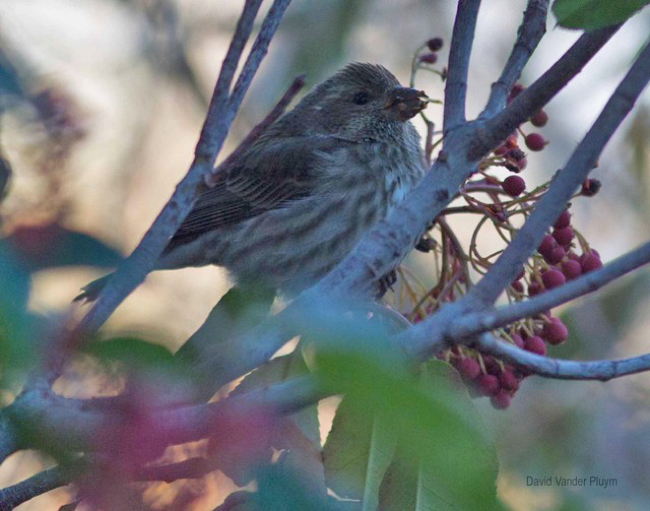The official ornithological Fall Season ended 30 November for administrative purposes. Birds don’t give a hoot, pardon the pun, about the administration of their comings and goings but journals do. So for bird data purposes, Fall includes all of August through November even though birds migrate from mid June through December and into early January with a few gracing many Christmas Bird Counts across the nation. Late migrants trickle out as insect prey continues to diminish under our harsh winter conditions.
Inyo County had an amazing Fall, if one measures it by the number of casual species recorded. A casual species has been recorded very few times and averages six or fewer years per decade. They are not normally present during an “appropriate” season but over time a pattern has appeared. These are species that when a birder finds one he/she first grabs their camera to take images and then grabs their phone to call others who help get the word out. There were gobs of pixels and user minutes used up this fall!
Undoubtedly the most exciting find, and first record ever for Inyo County, occurred 27 October when Steve Brad found a Groove-billed Ani at the Coso Rest Area. This species is resident throughout most of Mexico, Central America, and northern South America and just barely gets into southern Texas. There are 11 previous records in California with the last one reported in 1998. Most records fall between mid September and late December with one record mid April to early June and another record early December to early May. This will be the 12th state record after it is reviewed and accepted by the California Bird Records Committee, the northernmost ani in the state, and it falls in the middle of the state’s Fall season window. Steve is to be commended for following the proper protocol-photographing first and getting the word out. People from all over the state for the next few days tried to get to Coso to see the bird and many were successful if they didn’t arrive after 28 October.

Glaucous-winged Gull, Bishop City Park. Bishop City Park attracts “tourists” from all over! Photo by Chris Howard

Gorgeous Tropical Kingbird visits Death Valley – 3rd Inyo County Record. Photo taken at Stovepipe Wellsby Chris Howard
And the list continues:
- Mountain Plover photographed at Furnace Creek Ranch 26 August (SHS)
- Red Phalarope photographed at Owens Lake 20 August (C RH)
- Common Ground-Dove with one bird photographed at Deep Springs College (restricted access) 10–11 October (SLS, et al.) and 1–2 birds (1 photographed, KH-L) at the Independence woodlot 26 October–7 December (JTZ, UL)
- Eastern Phoebe photographed in Shoshone 29 October (JCS) (photo below)
- Purple Martin a well-described male at Tinemaha Reservoir 3 September (CAM)
- Chestnut-sided Warbler photographed at China Ranch 15 September (LSW)
- Painted Bunting adult male in Shoshone 25 October (PAD) continued through 29 October when photographed (JCS)
- Baltimore Oriole 1 well-described immature at China Ranch 12 September (AEK) and
- Purple Finch with 1 well-described female plumaged bird at Furnace Creek Inn 18 September (JEP), another well-described female-type at Furnace Creek Ranch 5 November (BRC), and up to five birds, all immature/female types withtwo photographed, in Bishop 26–29 November (DVP, LBH) (photo below)
Inyo County is the beneficiary of a cadre of birders who are also bird data gatherers. The difference is multifold but basically data gatherers take a professional path and strive mightily to prove their avian claims. Photographs are the preferred type of evidence, by both the birders and the county coordinators, but some birds do not cooperate so bird data gatherers get out their notebooks and begin writing descriptions…in the field or very shortly after seeing the bird and before looking in a field guide. They describe the bird — its looks, vocalizations, behavior, etc. — and add depth to the bird by describing the habitat and a descriptive story of the event. What they leave behind is not a stadium full of raised hands claiming this, that, or the other, but reliable data that will be carefully stored and excitedly searched by those not yet born that explains what was where, when, and in what numbers. To them we offer our gratitude and the gratitude of the future who will be thrilled with access to an amazing collection of reliable data.
We tip our hats to the bird data gatherers in this article, alphabetized by first initial: Brent Campos, Chris Rosie Howard, Curtis Marantz, David Vander Pluym, Jerry Zatorski, Jim Pike, John Sterling, Kelli Heindel-Levinson, Lauren Harter, Len Warren, Patrick Donnelly, Rick Karen Scott, Sandy Koonce, Stephanie Stewart, Steve Brad, Susan Steele, and Ulla Lipp, plus 14 others whose names did not appear in this article but whose dozens and dozens of records will be added to the Inyo County Avian database.
Happy New Year to all and to all a good night!
Tags: blackbird, finch, kingbird, plover, thrasher, warbler



